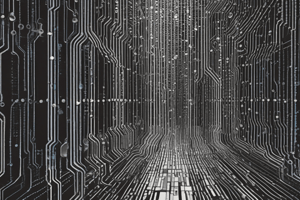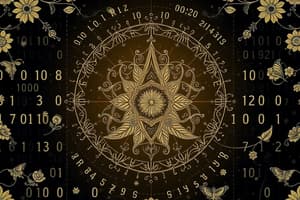Podcast
Questions and Answers
Why is the hexadecimal system useful in digital technology?
Why is the hexadecimal system useful in digital technology?
- It is more compact than the decimal system.
- It simplifies the representation and handling of binary numbers for humans. (correct)
- It is the only system that digital systems can directly process.
- It facilitates complex mathematical operations within digital circuits.
In the decimal number 2745.214, what is the positional value, or weight, of the digit '7'?
In the decimal number 2745.214, what is the positional value, or weight, of the digit '7'?
- $10^1$
- $10^3$
- $10^{-1}$
- $10^2$ (correct)
What is the decimal equivalent of the binary number 1011.101?
What is the decimal equivalent of the binary number 1011.101?
- 11.625 (correct)
- 12.750
- 10.500
- 9.625
Using direct conversion, what is the decimal equivalent of the binary number 11011?
Using direct conversion, what is the decimal equivalent of the binary number 11011?
What result would you get when applying the double-dabble method to convert the binary number 11011 to decimal?
What result would you get when applying the double-dabble method to convert the binary number 11011 to decimal?
How is the decimal number 25 converted to binary using successive divisions by 2?
How is the decimal number 25 converted to binary using successive divisions by 2?
When converting the decimal number 45 to binary by factoring into powers of 2, which binary representation is correct?
When converting the decimal number 45 to binary by factoring into powers of 2, which binary representation is correct?
What distinguishes the Binary Coded Decimal (BCD) representation from the pure binary representation of a decimal number?
What distinguishes the Binary Coded Decimal (BCD) representation from the pure binary representation of a decimal number?
What happens if a BCD-encoded number has a binary group greater than 9 (decimal)?
What happens if a BCD-encoded number has a binary group greater than 9 (decimal)?
Why is Gray code used in digital systems?
Why is Gray code used in digital systems?
Which of the following is a key application of Gray code?
Which of the following is a key application of Gray code?
In the context of error detection, what is the purpose of a parity bit?
In the context of error detection, what is the purpose of a parity bit?
How is the position of the parity bit determined within a coded word?
How is the position of the parity bit determined within a coded word?
If a system employs even parity, what must be true about its parity bit?
If a system employs even parity, what must be true about its parity bit?
What is the primary function of a 'nibble' in digital systems?
What is the primary function of a 'nibble' in digital systems?
What is the hexadecimal equivalent of the decimal number 423?
What is the hexadecimal equivalent of the decimal number 423?
What is the decimal equivalent of the hexadecimal number 2AF?
What is the decimal equivalent of the hexadecimal number 2AF?
What are the most common number systems used in digital technology, as referenced in the material?
What are the most common number systems used in digital technology, as referenced in the material?
If you need to convert the binary number 101110100110 to hexadecimal, how should you group the digits?
If you need to convert the binary number 101110100110 to hexadecimal, how should you group the digits?
What hexadecimal value corresponds to the binary sequence 1011 1010 0110?
What hexadecimal value corresponds to the binary sequence 1011 1010 0110?
What is the main advantage of using the double-dabble method for binary to decimal conversion over direct conversion?
What is the main advantage of using the double-dabble method for binary to decimal conversion over direct conversion?
Which statement accurately describes the process of converting a decimal number to binary using factorization into powers of 2?
Which statement accurately describes the process of converting a decimal number to binary using factorization into powers of 2?
In the context of applying codes and digital systems, what is a 'word'?
In the context of applying codes and digital systems, what is a 'word'?
What is the bit of parity is setado for that a quantity de 1's seja ímpar?
What is the bit of parity is setado for that a quantity de 1's seja ímpar?
What does the acronym MSB represent?
What does the acronym MSB represent?
What is 9F2 in binary?
What is 9F2 in binary?
What does ASCII stand for?
What does ASCII stand for?
If a bit of paridade is posicionado no bit mais significativo, what can you say about that bit?
If a bit of paridade is posicionado no bit mais significativo, what can you say about that bit?
Why can there be reading errors in Gray Code?
Why can there be reading errors in Gray Code?
How many bits divide 360° with precisão?
How many bits divide 360° with precisão?
With 9 bits divide 360° com precisão, o que dizer?
With 9 bits divide 360° com precisão, o que dizer?
What is the codificacão called when um número decimal é representado por seu número binário equivalente?
What is the codificacão called when um número decimal é representado por seu número binário equivalente?
Convert 423 to hexadecimal:
Convert 423 to hexadecimal:
What is the decimal conversion of 19h?
What is the decimal conversion of 19h?
Flashcards
Binary number system
Binary number system
A system that uses only two digits, 0 and 1, to represent numbers.
Decimal number system
Decimal number system
A number system with base 10, using digits 0-9.
Hexadecimal number system
Hexadecimal number system
A positional numeral system with a base of 16. It uses sixteen distinct symbols, 0-9 and A-F.
Number representation
Number representation
Signup and view all the flashcards
Binary to decimal conversion
Binary to decimal conversion
Signup and view all the flashcards
Decimal to binary conversion
Decimal to binary conversion
Signup and view all the flashcards
Decimal to Hexadecimal conversion
Decimal to Hexadecimal conversion
Signup and view all the flashcards
Hexadecimal to decimal conversion
Hexadecimal to decimal conversion
Signup and view all the flashcards
Hexadecimal to Binary conversion
Hexadecimal to Binary conversion
Signup and view all the flashcards
Binary to Hexadecimal conversion
Binary to Hexadecimal conversion
Signup and view all the flashcards
Binary Coded Decimal (BCD)
Binary Coded Decimal (BCD)
Signup and view all the flashcards
Gray Code
Gray Code
Signup and view all the flashcards
Parity Bit
Parity Bit
Signup and view all the flashcards
Even Parity
Even Parity
Signup and view all the flashcards
Odd Parity
Odd Parity
Signup and view all the flashcards
Study Notes
- Digital circuits involve numbering systems and codes that are common in digital technology like decimal, binary, and hexadecimal systems
- Digital systems operate using binary numbers
- Hexadecimal systems make it easier for humans to manage binary numbers
Decimal Numbering System
- Decimal counting ranges from 0 up to 103, 199, 999 and 1000.
- The number 2745.214 can be expressed as (2 × 10³) + (7 × 10²) + (4 × 10¹) + (5 × 10⁰) + (2 × 10⁻¹) + (1 × 10⁻²) + (4 × 10⁻³).
- Numbers represent a sum of the products of each digit's value and its positional value (weight)
Binary Numbering System
- Binary counting, using 23, 22, 21, and 20 weights, yields the decimal equivalents from 0 to 7
- A binary number like 1011.101 can be shown with positional values
- 1011.101₂ = (1 × 2³) + (0 × 2²) + (1 × 2¹) + (1 × 2⁰) + (1 × 2⁻¹) + (0 × 2⁻²) + (1 × 2⁻³) = 8 + 0 + 2 + 1 + 0.5 + 0 + 0.125 = 11.625₁₀.
Binary to Decimal Conversion
- Example 1: Convert 11011 to decimal: 12⁴ + 12³ + 0 + 12¹+ 12⁰ = 16 + 8 + 2 + 1 = 27₁₀
- Example 2: Converting 10110101 to decimal is 12⁷ + 0 + 12⁵ + 12⁴ + 0 + 12² + 0 + 1*2⁰ = 181₁₀
Binary to Decimal (Double-Dabble Method)
- Binary 1101 converts to decimal as follows: 1 * 2 = 2, +1 = 3 * 2 = 6, +0 = 6 * 2 = 12, +1 = 13 * 2 = 26, +1 = 27₁₀.
- Double-dabble conversion: Binary 10110101, with the double dabble method, turns into 181₁₀.
Decimal to Binary Conversion
- Divide successively by 2 and note the remainder for decimal to binary conversion.
- Example: Converting 25 to binary involves successive divisions by 2, the result is 11001₂
- Decimal to binary uses the factorization of powers of 2, with an algorithm
Hexadecimal Numbering System
- Hexadecimal has values from 0-9, and uses letters A-F, with 16 as the base
- Table 2.1 displays equivalencies among Hexadecimal, Decimal, and Binary
Decimal to Hex Conversion
- Requires division by 16
- 423 to Hex conversion example outputs 1A7₁₆
- 214 to Hex conversion example outputs D6₁₆
Hexadecimal to Decimal Conversion
- 16⁴, 16³, 16², 16¹, 16⁰, 16⁻¹, 16⁻²⁻³, and 16⁻⁴ are weights of hexadecimal digits
- Convert 356₁₆ to decimal as follows: 3 * 16² + 5 * 16¹ + 6 * 16⁰ = 768 + 80 + 6 = 854₁₀.
- Convert 2AF₁₆ to decimal as follows: 2 * 16² + 10 * 16¹ + 15 * 16⁰ = 512 + 160 + 15 = 687₁₀
Hexadecimal to Binary Conversions
- Each hex digit is converted into a 4-bit binary equivalent.
- As an example 9F2₁₆ --> 1001 1111 0010₂
- Hexadecimal numbering serves as a compact representation of binary numbers, which allows for easy conversion
Binary to Hex Conversion.
- Binary numbers are represented for numbers with 4 columns
BCD Codes
- A decimal number represented by its binary equivalent yields pure binary encoding
- Digits are converted with pure binary equivalent, while disregarding significance such as 874 is 1000 0111 0100
- The direct representation of 4-bit binary allows for fast Decimal/BCD conversions
BCD for Decimal
- 0110 1000 0011 1001 is 6839
- Binary codes exceeding 9 (decimal) are prohibited and indicate an error in the BCD number.
- The group referring to a prohibited code causes an error in that BCD number
Gray Code
- Bits may not simultaneously transition in a circuit and have incorrect readings in short time intervals
- Table 2.2 provides binary and Gray code equivalencies for three bits
Converting Binary to Gray
- There are different steps to converting binary to graycode, different results will be shown
Converting Gray to Binary
- There are different steps to converting graycode to binary, different results will be shown
Gray Code Applications
- Gray code has position encoders with three bits splitting 360° with 45° precession
- Gray code has position encoders with 9 bits splitting 360° with approximately 0.7° precession
ASCII Code
- Standard ASCII codes include character, Hex, and Decimal values
Parity Bit Error Detection
- A parity bit is an added bit appended that consists of bits for error detection
Parity Bit
- The bit of parity can be odd bit, or even bit
Parity Even
- Parity bit is set, so that the number of 1's is set as even bit
Parity Odd
- Parity bit is set, so that the number of 1's is set as odd bit
- An example of sending a character is "#"
Nibbles, Bytes, and Words
- A nibble contains 4 bits, an example is 1,0,1,0
- A byte has 8 bits equal to 2 nibbles like 0,1,1,0,1,0,1,0
- A Word (or Palavra) has groups of bits that represents a single information unit
- Word size depends on the number of binary word bits a system handles like 32 or 64
Studying That Suits You
Use AI to generate personalized quizzes and flashcards to suit your learning preferences.


